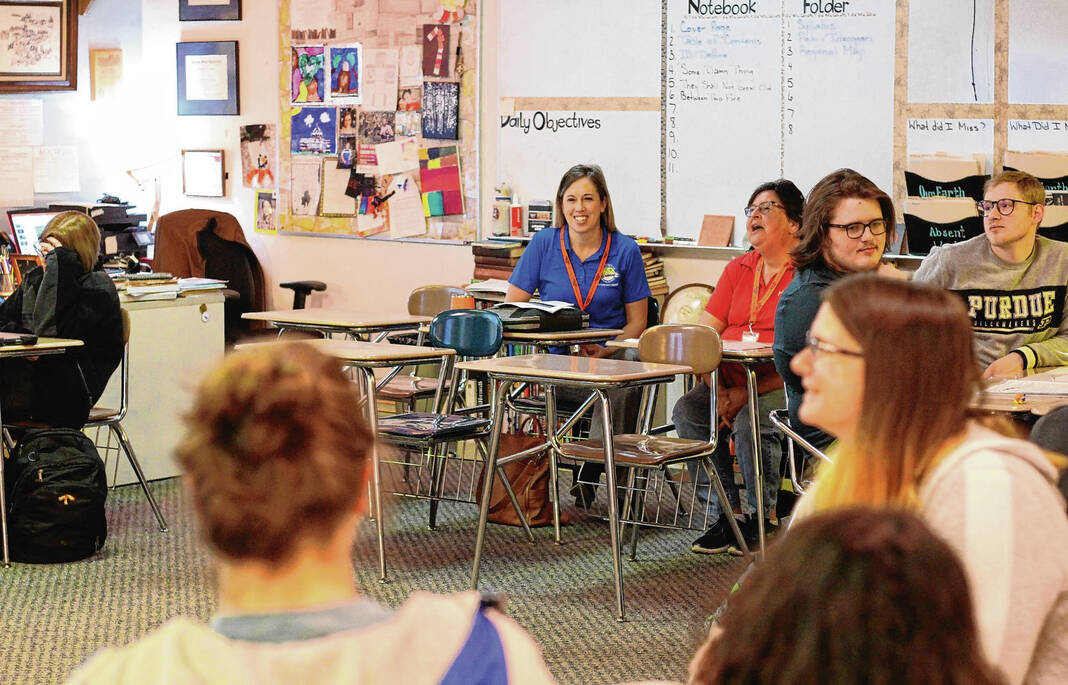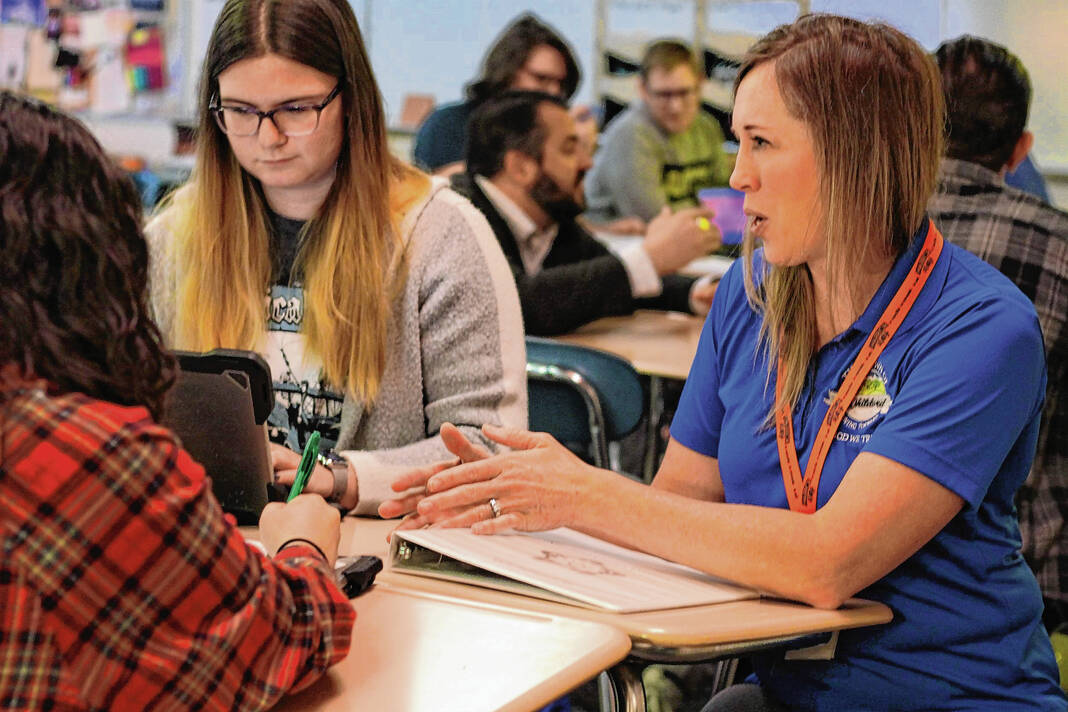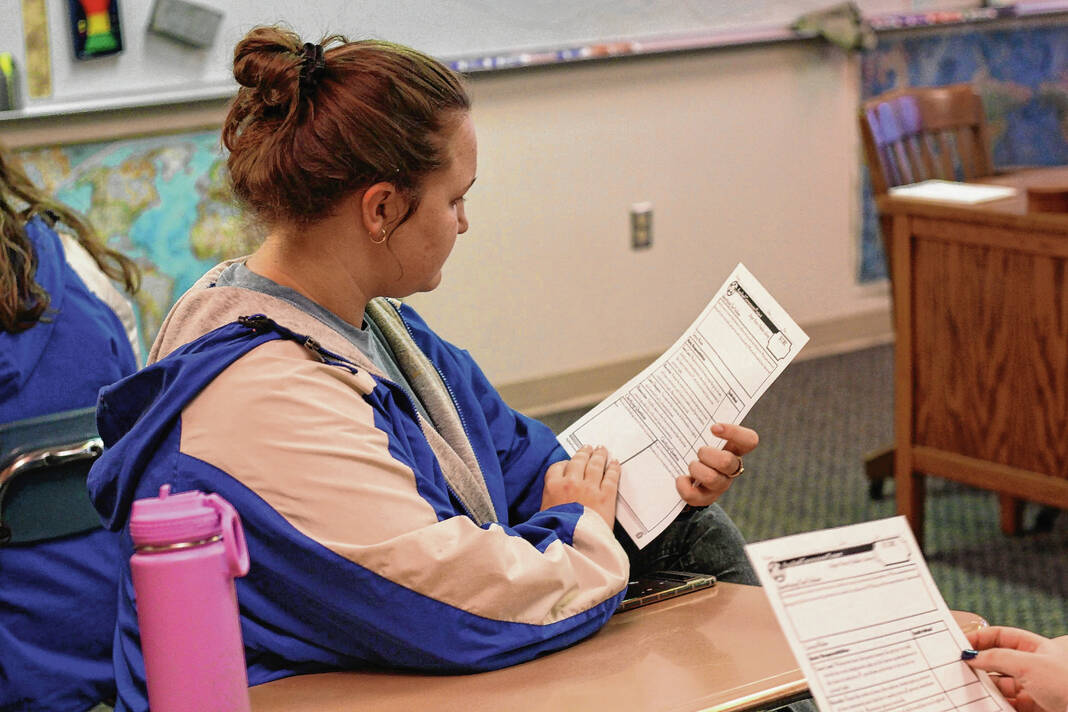
Students in Justin Schwenk’s government class at Whiteland Community High School are writing an emergency management plan for the town of Whiteland following the tornado that hit last month. Whiteland’s acting Town Manager Carmen Young and Johnson County Emergency Management Director Stephanie Sichting visited the class on Tuesday.
Whiteland needs a local emergency management plan, and a high school class is taking on the challenge.
When an EF-3 tornado tore through the town of Whiteland on March 31, town and county officials, other municipalities and the community mobilized to help in the emergency. Whiteland officials soon realized the town did not have its own emergency management or preparedness plan to enact.
Johnson County has an emergency plan for the entire county, per state law, so Whiteland was not entirely without a plan when the tornado hit. But having its own plan is now something town officials want to pursue to be better prepared locally.
Students in Justin Schwenk’s dual-credit government class at Whiteland Community High School are going to help with creating a new emergency plan for the town. This project is part of Schwenk’s new Applied Government Project, in which groups in the class work to come up with potential plans to solve local problems with government policies.
Schwenk started teaching social studies at WCHS in September, and the school brought back the dual-credit senior government class. With that class came his idea to create a project where students can work with local government officials to help solve local problems, through either writing policy, plans or coming up with other solutions.
The idea originally stemmed from a program from when he worked at Brown County Schools, and students in middle school STEM classes collaborated to help companies like Cummins and Cook Medical Group with projects.
“For years, I said, we can do this with local government,” Schwenk said. “When I came here I was thinking about, you know, government and action and an emphasis on civic duty and civic virtue … I thought, well maybe this is where I can do it.”
For this first project, Schwenk reached out the Carmen Young, now acting town manager for Whiteland, and asked if there were any problems in town the students could take on for a project. After the tornado hit, they decided on creating an emergency management plan, he said.
The project is just getting started, and students were split into groups of three or four to work on their own emergency management plans to present to Whiteland. As part of the first step, Young and Stephanie Sichting, Johnson County’s emergency management director, met with the class to give them background on the town and its current situation.
Experiencing a disaster like this was all new for Whiteland, and it was not something they were fully prepared for, Young said. They handled it the best they could with the resources and nearby help they had available. The town mobilized quickly, and their top priority was helping residents, she said.
“With the help of our police chief, our fire chief who is involved in a lot of state-led kind of incident command organizations … and then with the county emergency management, they practice these types of situations,” Y0ung said. “They have a guidebook, but I will tell you after an incident like this occurs, we’re not like, ‘OK, where’s the binder? Where’s the binder with the plan?’”
Young, who had to step into the role of town manager because the current manager is on medical leave, said she and town officials learned a lot about responding to a disaster over the last month. The town had to learn how to clean up debris properly, what to do with cleanup when their equipment was damaged in the storm, how to help people pay utility bills, among other challenges.
In the immediate aftermath, other municipalities and entities came to help, which Young said she was grateful for that and those relationships, but a plan may have helped organize everything a little more.
“There started to be a duplication of services, and just everybody doing what they thought was right. And because we didn’t have a plan that was like, OK, this what we’re doing, and this is the way it goes, people started stepping on each other’s toes,” Young said.
Sichting said Whiteland did an excellent job in managing the emergency. She went over how the county has a comprehensive emergency management plan, which goes over the scope of any possible disaster the county as a whole could face. That includes natural disasters like tornadoes and floods, or other disasters such as toxic chemical spills, train derailments or mass shootings.
An emergency management plan has to cover how to prepare, mitigate, respond and recover from an emergency. Preparedness refers to doing exercises or training on how to handle a certain emergency, such as how the county often does tabletop exercises for different scenarios. Mitigation refers to enacting measures that may reduce the chance of an emergency. Those could be done in the form of establishing different building requirements to make sturdier structures, for example.
The students in Schwenk’s class got to work on Tuesday starting their research to build their plans for Whiteland. They will work on their projects for the next month and present their plans to the town of Whiteland between May 23 and 25. The student groups are following five steps to complete the projects: 1. Identify a problem; 2. Research and define the problem; 3. Identify public policy solutions; 4. Develop an action plan; and 5. Present to stakeholders.
Young and Sichting will return throughout the month to continue working with the students on their plans, and answer any questions. Young also plans to invite some town council members to attend the project presentations. The end goal for Whiteland is to take the students’ plans, and likely synthesize them into one emergency management plan to be adopted by the town council.
For Schwenk, he hopes to bring this project back every semester, where students will be tasked with new local problems to tackle. He envisions the program expanding to also work with the county government, and maybe eventually state policy. The purpose of the project is to engage students with their local governments, and also teach them how to be innovative in finding solutions to issues that affect their community.
“The hope is pushing that idea that the right plan can result in real, authentic change,” Schwenk said.









